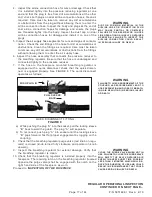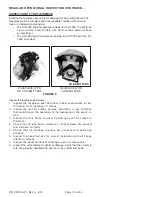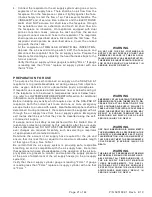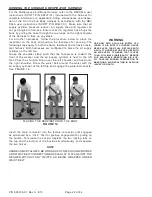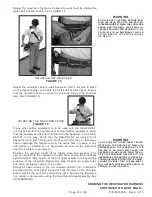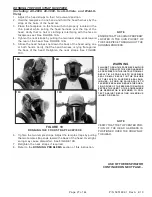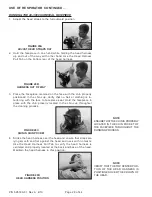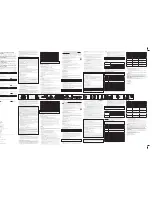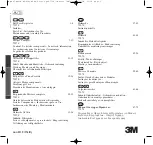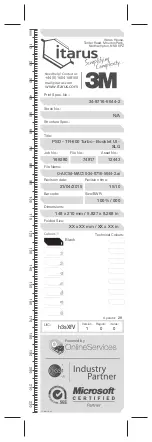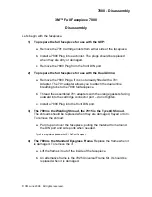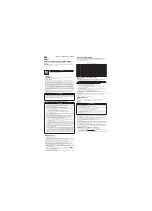
Page 13 of 44
P/N 595189-01 Rev A 4/10
WArning
dAmAged cylinderS mAy Suddenly
leAK or ruPTure if lefT chArged WiTh
comPreSSed Air. fAilure To inSPecT
for dAmAge And To emPTy The Air
from dAmAged cylinderS mAy reSulT
in SeriouS inJury or deATh.
WArning
ThiS inSPecTion Procedure reQuireS
uSing A SmAll AmounT of Air from The
Self-conTAined Air SuPPly cylinder
on eAch inSPecTion. if The cylinder
gAuge iS no longer reAding "full",
The cylinder muST be rechArged To
iTS full condiTion before reTurning
To Service. uSe of A cylinder Air SuP-
Ply ThAT iS leSS ThAn full mAy reSulT
in reduced durATion of The reSPirA-
Tor And mAy reSulT in Sudden Termi-
nATion of breAThing Air Which could
cAuSe SeriouS inJury or deATh.
WArning
folloW The regulAr oPerATionAl in-
SPecTion Procedure exAcTly. if The
Purge doeS noT AcTuATe AS deScribed
in ThiS inSTrucTion or Any oTher oP-
erATionAl mAlfuncTion iS noTed, do
noT uSe The reSPirATor. remove The
reSPirATor from Service And TAg iT
for rePAir by AuThoriZed PerSon-
nel. fAilure To ProPerly idenTify
mAlfuncTionS mAy reSulT in SeriouS
inJury or deATh.
WArning
regulArly inSPecT The SKA-PAK AT
reSPirATor including The elecTronic
AlArm AS deScribed in ThiS inSTruc-
Tion. verify ThAT The ProPer bATTer-
ieS Are uSed And ThAT There iS no
dAmAge To or modificATion of The
uniT ThAT Would imPAir The inTrinSic
SAfeTy. if The SKA-PAK AT iS uSed in An
exPloSive or flAmmAble ATmoSPhere,
fAilure To correcT condiTionS ThAT
mAy imPAir The inTrinSic SAfeTy of
The eQuiPmenT mAy leAd To A fire or
An exPloSion Which could reSulT in
SeriouS inJury or deATh.
regulAr oPerATionAl inSPecTion
The following procedure shall be used when you first receive the res-
pirator and for scheduled inspection of the respirator. All respirators
shall be inspected after each use. A respirator not routinely used but
kept for emergency use shall be inspected at least monthly. If dam-
age or discrepancies are noted during the inspection of the respirator,
remove the respirator from service and tag for repair by authorized
personnel.
Ensure that the cylinder valve is closed (push in and rotate the cyl-
inder valve knob full clockwise).
To vent any trapped air in the system, open the purge valve by rotat-
ing the red knob on the breathing regulator to the full counterclock-
wise position. Any trapped air will flow from the regulator. Close the
purge valve by rotating the knob to the full clockwise position when
air flow stops.
CYLINDER INSPECTION
noTe
IT IS THE RESPONSIBILITY OF THE USER TO ENSURE THAT ALL
DOT REQUIREMENTS FOR THE SELF-CONTAINED AIR SUPPLY
CYLINDER ON THIS RESPIRATOR ARE MET AND MAINTAINED.
1. Check the latest cylinder hydrostatic test date to ensure it is
current. All cylinders used with SCOTT self-contained breathing
apparatus must be visually inspected regularly and hydrostatically
tested by a licensed cylinder retester in accordance with the ap-
propriate US Department of Transportation (DOT) specification
or the applicable DOT exemption. For a complete listing of retest
date requirements, refer to the current revision of Safety Pre-
cautions for Air-Pak Cylinders, Scott P/N 89080-01, available on
request from Scott Health and Safety. Composite cylinders (those
cylinders utilizing fiber over wrap) must be tested in accordance
with the DOT exemption status up to the maximum life of fiber
overwrapped cylinders which, at the time of the publication of
this instruction, is 15 years from the date of manufacture. The
date of manufacture marked on the cylinder is also the date of
the first hydrostatic test. It is the responsibility of your organized
respiratory protection program to arrange for visual inspection and
hydrostatic testing of cylinders by a licensed retester.
2. Visually inspect cylinder and valve assembly for physical dam-
age such as dents or gouges in metal or in composite wrapping.
Cylinders which show physical damage or exposure to high heat
or flame, such as paint turned brown or black, decals charred
or missing, pressure gauge lens melted or elastomeric bumper
distorted, and cylinders which show evidence of exposure to
chemicals such as discoloration, cracks in the cylinder or the
composite wrapping, peeling of the outer layers of the composite
wrapping and/or bulging of the cylinder wall, shall be removed
from service and emptied of compressed air. Refer to current
applicable publications on compressed gas cylinder inspection
available from Compressed Gas Association Inc. (703-413-4341),
1725 Jefferson Davis Hwy., #1004, Arlington, VA 22202.
3. Check the cylinder gauge for a “FULL” indication. If the cylinder
pressure is less than “FULL,” replace the cylinder with a fully
charged cylinder or have the cylinder charged to the full condi-
tion.
Proceed to
HARNESS INSPECTION
.
regulAr oPerATionAl inSPecTion
conTinued on nexT PAge...

















